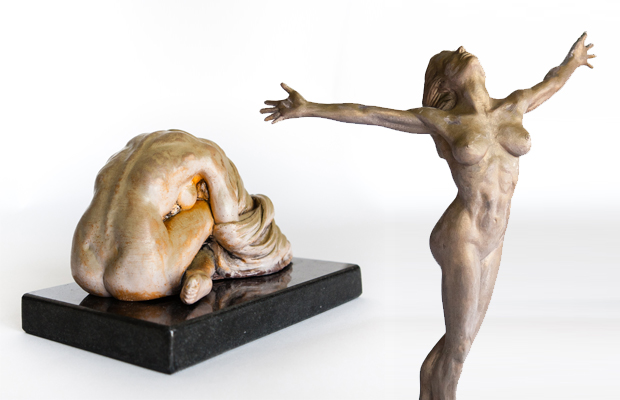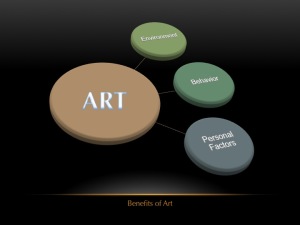A Tale of Two Sculptures
Last year during one of my shows, I observed a lady coming in to look at the artwork as I was talking to someone else. After looking at all the sculptures, she came back to Abased. She stood there for a while. Then she moved towards Freedom and stood there for a while. She went back to Abased, then back to Freedom. I observed while this continued for several minutes.

Abased & Freedom
Done with my conversation I approached the lady and introduced myself. I mentioned I was observing her going back and forth between the two sculptures. She mentioned how the sculptures were almost talking to her in a way she could not understand or articulate. I told the lady the definition of Abased (belittled or degraded). Instantly the conversation took an interesting turn. She said:
“That explains a lot. This is how my husband makes me feel (pointing at Abased) but I want to feel like that (turning and pointing at Freedom).”
Without saying another word, she turned away and left. I was stunned and honestly wished she stayed around longer. I was curious to find out more about what the sculptures were saying (figuratively speaking). Still, three things were clear during this short interaction. First, art has the power to speak to people. People can find a connection in art that generates a silent conversation with the soul, the logic, and the senses. No words are necessary for this connection.
On the other hand, some people need some help when they try to articulate that connection; when they try to understand what they see, what they feel, and what they perceive. While it is not necessary to explain some people seek for a deeper understanding, a hint, a spark that provides and explanation they can ponder. Again, it would be better for art never to be explained. Nevertheless, some people want to express their connection. That cannot be denied. Otherwise, we might be shutting down their interest and a great opportunity to provoke consciousness.
[Read also: How to Explain your Art & Artists are Communicators]
That takes me to the third point: expressing the connection could be the first step towards healing. Too bad the encounter was cut short. When someone understands their internal situation (and sometimes external) through art, and consciously expresses that revelation, healing is possible. Articulating what no words can explain (which not necessarily is a contradiction) could transform a life, and that is one of the most rewarding achievements of art.
[Read also: Art Changing Lives]


Too Old To Dream
Sometimes I feel too old to dream anymore
I guess it took me long enough to get back to writing for this blog. It is time to get back at it. I hope the title stirred up your curiosity. Sometimes I feel too old to dream anymore. No, I didn’t lose my edge, or neither I think that dreams are not important. I will always be a dreamer. However, it is time to take action and make those dreams happen. I’ve been trying to understand my path in life, the reasons for my experience, academics, my art, my skills, my weaknesses, my mistakes, those apparent failures, and moreover, the dreams I have for my life. I discovered soon enough that all of it was never about me.
My wife and I have been reading, seeking information, reaching out to organizations, and talking to people about human trafficking, and more specifically, domestic sex trafficking victims. While this is not a foreign subject for us, it was until recently that our hearts began burning for these victims, their trauma, their restoration, and the future they can have through freedom and healing. I’ve been assessing the tools I have and how these can be used for this purpose. I have to start with what I have no matter how little and insignificant it may look. To be specific, I have on one hand my academic preparation, teaching and research experience, and on the other hand, art. How do these two connect?
I shared before about social learning theory and how it helps to understand human behavior and antecedents to develop strategies for teaching and learning more effectively. In the past year or so, I’ve been contributing to some expansion of the theory not only in the complexity of factors of causation, but also in the application of the theory beyond the realm of learning. Adding the affective and the spiritual domains, and making the physical domain broader than just psychomotor skills, along with how the interactions of factors produce more than just self-efficacy and agency, are some of the things I’ve been working on. Also, I’ve been working on understanding how this theory is useful for trauma treatment. Moreover, I’ve been understanding in deeper ways how the benefits of the creative process are a tool to facilitate the healing process. I know it is a lot to grasp in a short post. I am putting together a research article on it.
This effort is just one piece of the puzzle. My wife is working on her piece of the puzzle too. She is working on the physical aspects of trauma through a holistic health approach. At the same time, she is connecting to mental health professionals to focus in the counseling and support aspects. All together is forming a inter-disciplinary and inter-professional holistic approach that focuses on the person being restored. Better yet, with every passing day, this is no longer a dream. The pieces are coming together to become a reality. Life is about to take a turn in a direction that is still unknown to us, and more importantly, to the people this is about.